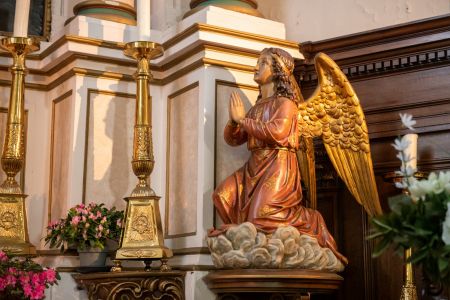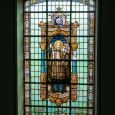Church | 1287 | Gothic, Classical | Catholic Church




Map
Opening hours
01 January - 31 December
Mon 10.00 - 18.00
Tue 10.00 - 18.00
Wed 10.00 - 18.00
Thu 10.00 - 18.00
Fri 10.00 - 18.00
Sat 10.00 - 18.00
Sun 10.00 - 18.00
Religious offices
Description
The current tower dates from the 16th century. The aisles were added in 1773. Now it is a three-aisled hall church under three gable roofs. In the second half of the 16th century, the church is said to have been used by the Protestant worship and was to that end restored after the destruction that took place in 1580. In 2020, the restoration of the tower, the roofs, and the cavalry of the church was completed.
From the outside, one can see on the north portal that was added in 1923, a tile panel with figures of angels, chalice and the text 'Reverence to God’s house’. Under the canopy on the east wall hangs a crucifix under a shelter above a purgatory scene. The rock mountain behind a decorated blue stone fence has three skulls and two decorative vases.
Built into the fence around the cemetery, one can see a monument for the fallen (1921). The fences were repaired in 2015 after an accident took place. Along the street side, seven (recently replaced) oaks dominate the view, together with a work of art from the trunk of a felled oak (2022, Robin Uzeel). The name “Zeveneken” is said to be a reference to seven oaks.
The interior in classical style was recently repainted. It contains several paintings and a side altar, all dedicated to Saint Eligius. The altar cloth “Jesus on the Cross” is from P. Beernaert (1653), the oldest element in the entire decor. The choir stalls are from the 18th century and the paneling is from the 17th or 18th century. There’s a 17th century pulpit and the communion rails are from the 18th century. The Van Peteghem organ was renewed several times.
KIKIRPA : Photo-library on line
Photos
Remarkable elements
Main altar
In 1766, this baroque altar replaced an earlier altar that is still preserved underneath. It is a wooden portico altar flanked by two columns with above it a statue of God the Father sculpted by Mathias Zens in 1882. The painting in the middle represents the Coup de Lance and was painted by Ph. Beirnaert in 1653. The neo-classical tabernacle was made in 1832 by the brothers Nimmegeers from the village of Zaffelare who also made the choir stalls in 1857. Both cherubs were purchased in 1837.
Processional statue of Saint Eligius
This beautifully sculpted neo-Gothic statue from linden wood was made by Remi Rooms in 1894 and was consecrated on December 1, 1896. Saint Eligius is represented as a bishop under a baldachin. As an attribute he holds a crowned hammer in his hand. The statue was carried during the procession and was also put on display during the horse blessing, now car consecration that takes place every year on June 29th.
Stained glass windows
During the period 1922-1928 A. Van Doorne from the city of Ghent created twelve colorful stained glass windows. They were donated by the parishioners, like the widow that was dedicated to Saint Eligius, or by wealthy citizens like the mayor and the physician Philemon Pauwels. Both windows that were gifted by Gustaaf De Smul pay homage to his fallen son and to his deceased wife.
The saints are depicted in a portico and are either crowned by a pediment or by two volutes with a medallion in the center. In the windows, elements of local history were integrated.
Painting representing the episcopal ordination of Saint Eligius
Eighteenth century painting created by a still unknown Flemish master. Four bishops wearing mitres accompanied by two monks place the bishop’s mitre on Saint Eligius’ head. The painting is part of a series of three.
In the north aisle, Saint Eligius’ honesty is being depicted by the offering of a second saddle to King Clothar II. The painting in the south aisle shows Saint Eligius’ charity work through him handing out alms.
Van Peteghem organ
In 1775, the Lambert-Benoît Van Peteghem organ was installed. The organ originally had one manual and was expanded in 1871 by Petrus Joannes Vereecken into a romantic organ with two manuals. During the recent restoration (2010-2020), these additions were removed from the organ.
The organ case was made by Alexander Nuten in a beautiful rococo style with integration of musical instruments. Only the southern organ case has organ pipes. In 1932, the airy supply was modernized with an electric pump, but the original bellows are still present.
Calvary
On the east side of the church stands a beautiful calvary from the end of the eighteenth century. The calvary group under the canopy was thoroughly restored during 2020-2021. Originally, the group of statues was located at the northeast side of the church, but it was moved to make space for the northern sacristy.
Above the bone house, where the three skulls that decorated the border that were stolen used to be, one can see a lively purgatory integrated in an artificial rock formation. Above it there’s a massive cross with a snake curling upwards at the base. The original background painting that represented heavenly Jerusalem, was replaced by an even brown surface.



























